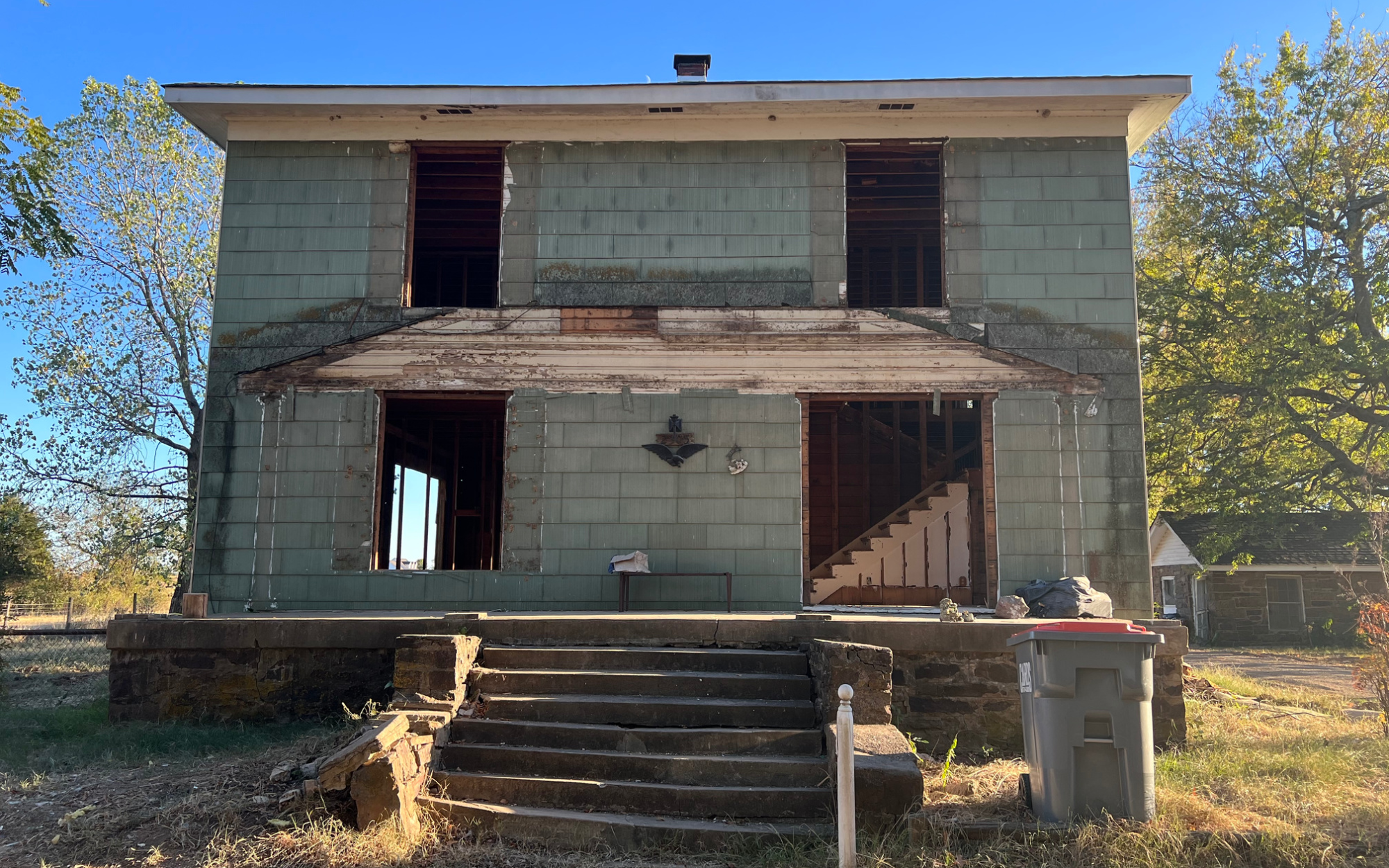I’m sorry to tell you that you’ll never have the pleasure of meeting Joseph Robert (Bob) Ebbing and his wife, Colyne Williams Ebbing. Bob, born in 1931, died in 2015. His wife, born in 1936, passed away three years later. Both worked at Dixie Cup in Fort Smith, Arkansas, but they lived in Barling on a farm that covered fifty-nine acres. The Ebbings adored their life. Even in death, they sent that message. Their double headstone at Saint Mary’s Cemetery shows a tractor, a barn, and a set of wedding bands – their wedding date engraved into the stone: May 4, 1956.
***
By 1956, Bob and Colyne Ebbing had a plan. They’d buy an old farmhouse and fill it with their children. They’d work the land. When there was a chance, they’d go camping or take a trip to the lake.
In 1957, they bought their piece of paradise, set on the highest point in Barling, with a green, two-story house built between 1901 and 1903. They planted peas and sweet potatoes—massive amounts of the latter. They bought Black Angus cattle. Bob grew to cherish those cows, even when one injured him enough to cost him a stay in the hospital. When he came home, he only bought more.
They tried for a family, waiting for their babies to arrive, but none ever did. The two weathered their disappointment. When their nieces and nephews visited, the Ebbings covered them with love. And when it was harvesttime on the farm, those same kids and their families showed up to help.
One of the nephews is Richard Weindel, who’s now on the fading side of middle age. He stands in the old Ebbing house, marveling at the restored long-grain pine floors. When they were refurbished, a piece of the flooring had to be replaced, which could have caused a hardship. Developer Steve Gann, a partner in Barling Place, LLC, says they don’t make floors like that anymore. Luckily, their carpenter happened to have one lonely piece of long-grain pine in his barn and offered it up like a prize.
It was one of the many tense moments during the remaking of the Ebbing farmhouse. Steve talks about missed deadlines and a reasonable budget that blossomed into a weedy field. He throws around words about the old house: knob-and-tube wiring, plaster walls, and—the best surprise—craftsman-like framing that fit together like a Lincoln Log set.
Today, the house on its remaining half-acre is a reimagining of the old—the 120-year-old framing remains, as do some of the original floors and stairs, a water well in the garage, a tiny rock house where farm workers used to stay, and a stone basement that once held the family’s sweet potato harvest.
The rest is a shiny new farmhouse that looks like something out of a Restoration Hardware catalog. If designer Joanna Gaines stepped out on the porch with a smudge of paint on her cheek from her latest renovation project, you wouldn’t be surprised.
Richard taps a rectangle of darker wood on the living room floor with his toe. It’s a section where carpenters removed a wall to enlarge the space. Richard says, “I can still see how it used to be. This house was in my backyard growing up.” He points. “Uncle Bob and Aunt Colyne’s farm adjoined my grandpa’s (Mom and Uncle Bob’s dad’s) farm. There used to be three tractors here. I took them home to my house.” Richard had been riding one of those tractors since he was five.
Richard tries to explain what life was like then, at a time when Barling seemed a great distance from Fort Smith. He remembers the drive to the now-closed St. Anne’s Catholic High School in the 1970s, where he was a student. “We called it ‘crossing the prairie,'” Richard says, tugging his ball cap’s brim. The bigger city seemed eons away.
Richard learned how to make do with what you had. “When something breaks on a farm, you fix it. You don’t call a plumber or an electrician. Uncle Bob was the same way. He fixed things. He built his first stock trailer. He built a flatbed trailer.”
Richard’s son Heath, a mechanical engineer, is standing beside his dad. “My friends joke about me. I’m always fixing something. But that’s what I know.” Physical labor was only part of it. “My best memory is watching fireworks. We determined this was the highest point in Barling. You could watch the [Fourth of July] fireworks from Fort Smith, Greenwood, everywhere. The F16s [from the 188 Air National Guard] used to fly right over this area. In the summers, when we’d be working on the farm, we’d see them fly over.”
Heath has a hundred stories about his Uncle Bob and Aunt Colyne. “She was my favorite aunt,” he says. Many of those stories end with Uncle Bob, a Korean War veteran with a Bronze Star and Purple Heart, saying, “Don’t tell Colyne.” Like the time Heath was helping him roof the tiny rock house and ran out of green shingles. On the side farthest from the main house’s window, Uncle Bob pulled out some old leftover black shingles that didn’t match at all. With his mouth set just so, he said to Heath, “Let’s not tell Colyne.” Richard agrees, shakes his head, and smiles.
After Bob and Colyne passed, the farm was left to their nieces and nephews. There was no easy way to divide the land, so the group decided to sell. When Barling Place, LLC bought the property, they planned a neighborhood. A street would run through where the house stood. But Steve Gann’s wife, Rebecca, wasn’t having it.
She could see a new story ready to be written. After a convincing argument, the street was rerouted, saving the Ebbing farmhouse from demolition. At the time of this writing, the three-bedroom, two-and-a-half-bath house had yet to be sold. Rebecca designed the interior with a new chapter in mind, choosing things like a new brick floor in the kitchen, hoping the right buyers would walk in and say “home.”
Steve wants the buyer to hear the story of how they found 2,000 bushel baskets in the basement. He wants them to know that the original framing studs were carved into planks of wood that stood two stories high. He wants them to see the original well in the garage, which is untapped but ready to provide water again, and the stone basement that nearly vibrates with memories of life on an Arkansas farm. “They just don’t make ’em like that anymore,” Steve said. They really don’t.
All old things become new again, given enough care. The Ebbing house is an example. The old red oak standing in the front yard bears witness. There was a farm in Barling. Now, there’s this house filled with memories, restored and ready for a new family. I wish we could have met Uncle Bob and Aunt Colyne. At least now, we know what kind of people they were—they were the best of how it used to be.
Find images of The Ebbing House, then and now, in our June 2024, digital edition.
WORDS Marla Cantrell
IMAGES courtesy Richard and Heath Weindel and BN Focus Productions




